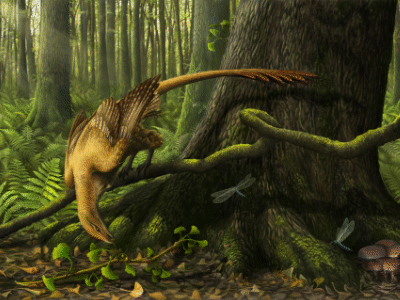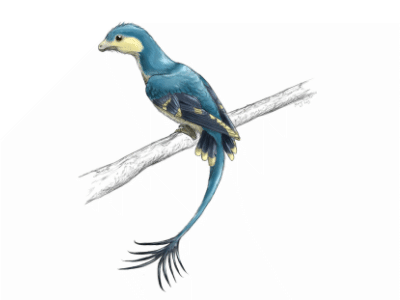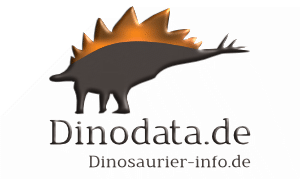Jeholornis prima

Zhou, Zhang, 2002
Klassifizierung: Jeholornithidae
Ernährung: herbivor
Bedeutung des Namen: Vogel aus Jehol
Neben Aurornis und Archaeopteryx ist Jeholornis einer der bisher bekanntesten ursprünglichen Vögel, von ihm wurden über 100 Fossilien entdeckt, von denen jedoch nur ein Bruchteil wissenschaftlich beschrieben ist. Die Ernährung dieses Vogels ist den Wissenschaftlern bekannt, da im Bauchraum eines Fossils Abdrücke von Samenkörnern entdeckt wurden. Jeholornis war zwar weiter entwickelt als Archaeopteryx, besaß aber ebenso wie dieser einen langen Schwanz und kleine Zähne in seinem Schnabel. Jeholornis war ungefähr so groß wie ein rezenter Truthahn. Er war damit einer der größten Vögel der Kreidezeit. Auffällig an Jeholornis waren die großen, kräftigen Flügel und die Krallenfüße, die ihm wahrscheinlich ein Leben in den Bäumen ermöglicht haben. Der 35 Zentimeter lange knochige Schwanz erinnert noch stark an die Dinosaurier-Vorfahren dieses Vogels. Bei einigen Fossilien von Jeholornis sind auch Abdrücke der Federn erhalten.
Weitere Spezies:
Jeholornis palmapenis
Jeholornis curvipes
- - - - -
Spannweite: 1 m
Gewicht: 500 g
Holotyp: IVPP V13274
Fundort: Jiufotang Formation, Dapingfang, Provinz Liaoning, China

© Dinodata.de

© Ivan Walsh

© Emily Willoughby

© Maija Karala
Weitere Informationen
A long-tailed, seed-eating bird from the Early Cretaceous of China / Zhonghe Zhou, Fucheng Zhang, 2002 / Nature, 418(6896), pp. 405-409
/ Zhonghe Zhou, Fucheng Zhang, 2002 / Nature, 418(6896), pp. 405-409
A new long-tailed basal bird from the Lower Cretaceous of north-eastern China / Ulysse Lefèvre, Dongyu Hu, François Escuillié, Gareth J Dyke, Pascal Godefroit, 2014 / Biological Journal of the Linnean Society 11/2014; 113(3). DOI: 10.1111/bij.12343
A new species of Jeholornis with complete caudal integument / Jingmai K. O’Connor, Chengkai Sun, Xing Xu, Xiaolin Wang, Zhonghe Zhou, 2011 / Historical Biology 24 (1), pp. 29–41
Basal birds from China: a brief review / Li Dongsheng, Corwin Sullivan, Zhou Zhonghe, Zhang Fucheng, 2010 / Chinese Birds 2010, 1(2) 83-96 DOI: 10.5122/cbirds.2010.0002
Earliest evidence for fruit consumption and potential seed dispersal by birds / Han Hu, Yan Wang, Paul G McDonald, Stephen Wroe, Jingmai K O'Connor, Alexander Bjarnason, Joseph J Bevitt, Xuwei Yin, Xiaoting Zheng, Zhonghe Zhou, Roger BJ Benson, 2022 / eLife 2022;11:e74751. DOI: https://doi.org/10.7554/eLife.74751 /
/ Han Hu, Yan Wang, Paul G McDonald, Stephen Wroe, Jingmai K O'Connor, Alexander Bjarnason, Joseph J Bevitt, Xuwei Yin, Xiaoting Zheng, Zhonghe Zhou, Roger BJ Benson, 2022 / eLife 2022;11:e74751. DOI: https://doi.org/10.7554/eLife.74751 / PDF
PDF
Intra-gastric phytoliths provide evidence for folivory in basal avialans of the Early Cretaceous Jehol Biota / Yan Wu, Yong Ge, Han Hu, Thomas A. Stidham, Zhiheng Li, Alida M. Bailleul, Zhonghe Zhou, 2023 / Nature Communications, Volume 14, Article number: 4558 (2023. https://doi.org/10.1038/s41467-023-40311-z /
/ Yan Wu, Yong Ge, Han Hu, Thomas A. Stidham, Zhiheng Li, Alida M. Bailleul, Zhonghe Zhou, 2023 / Nature Communications, Volume 14, Article number: 4558 (2023. https://doi.org/10.1038/s41467-023-40311-z / PDF
PDF
Intraskeletal histovariability, allometric growth patterns, and their functional implications in bird-like dinosaurs / Edina Prondvai, Pascal Godefroit, Dominique Adriaens, Dong-Yu Hu, 2018 /
Scientific Reports 8, Article number: 258 (2018). doi:10.1038/s41598-017-18218-9 /
/ Edina Prondvai, Pascal Godefroit, Dominique Adriaens, Dong-Yu Hu, 2018 /
Scientific Reports 8, Article number: 258 (2018). doi:10.1038/s41598-017-18218-9 / PDF
PDF
The histology of two female Early Cretaceous birds / Jingmai K. O’Connor, Wang Min, Zheng Xiao-Ting, Wang Xiao-Li, Zhou Zhong-He, 2014 / Vertebrata Pal Asiatica 52(1), 2014, pp. 112-128
/ Jingmai K. O’Connor, Wang Min, Zheng Xiao-Ting, Wang Xiao-Li, Zhou Zhong-He, 2014 / Vertebrata Pal Asiatica 52(1), 2014, pp. 112-128
The Jehol Biota, an Early Cretaceous terrestrial Lagerstätte: new discoveries and implications / Zhonghe Zhou, 2014 / National Science Review 1: 543–559, 2014 /
/ Zhonghe Zhou, 2014 / National Science Review 1: 543–559, 2014 / PDF
PDF
Ultramicrostructural reductions in teeth: implications for dietary transition from non-avian dinosaurs to birds / Zhiheng Li, Chun-Chieh Wang, Min Wang, Cheng-Cheng Chiang, Yan Wang, Xiaoting Zheng, E-Wen Huang, Kiko Hsiao, Zhonghe Zhou, 2020 / BMC Evolutionary Biology, Volume 20, Article number: 46 (2020)
/ Zhiheng Li, Chun-Chieh Wang, Min Wang, Cheng-Cheng Chiang, Yan Wang, Xiaoting Zheng, E-Wen Huang, Kiko Hsiao, Zhonghe Zhou, 2020 / BMC Evolutionary Biology, Volume 20, Article number: 46 (2020)  PDF
PDF
Unique caudal plumage of Jeholornis and complex tail evolution in early birds / Jingmai O’Connor, Xiaoli Wang, Corwin Sullivan, Xiaoting Zheng, Pablo Tubaro Xiaomei Zhang, Zhonghe Zhou, 2013 / PNAS vol. 110 no. 43 17404-17408, Oktober 2013 / PDF
PDF
- - - - -
Bildlizenzen
Größenvergleich © Dinodata.de:
 Creative Commons 4.0 International (CC BY 4.0)
Creative Commons 4.0 International (CC BY 4.0)
Fossil des Jeholornis /
Ivan Walsh:
 Creative Commons 2.0 Generic (CC BY 2.0)
Creative Commons 2.0 Generic (CC BY 2.0)
- - - - -
Grafiken und Illustrationen von Emily Willoughby
Grafiken und Illustrationen von Maija Karala



